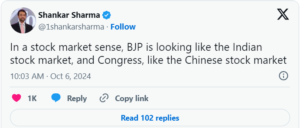Prior to the release of the results, market expert Shankar Sharma said that the BJP was “looking like the Indian stock market & Congress like the Chinese.”
Votes in the assembly elections of Jammu & Kashmir and Haryana will be tallied as October 8 draws near. The three phases of the J&K elections—scheduled for September 18, 25, and October 1—as well as the single-phase election in Haryana, scheduled for October 5, are being widely watched for their possible influence on the market and political importance.
Not only will the results of these elections be political, but financial markets are also anticipated to be impacted. In its most recent strategy note, Motilal Oswal Financial Services Ltd (MOFSL) stated that “the outcomes of the recent state elections in Haryana and Jammu & Kashmir, while not a needle mover, may keep the markets on edge, as exit polls predicted losses for the BJP in both Haryana and Jammu & Kashmir.”
Shankar Sharma, a market expert, offered his thoughts on how the elections would affect India’s financial system. He compared the two major parties to the financial markets of China and India in a tweet, writing, “In a stock market sense, BJP is looking like the Indian stock market, and Congress, like the Chinese stock market.”
This occurs before the outcome of the local elections. This year, Nifty has seen volatility throughout the course of two quarterly corporate earnings announcements. The index hit an all-time high of 23,338.7 on June 3 despite only being up 142 points for the year. Notably, the benchmark BSE Sensex saw a 3.4% spike on July 4 and closed at a record high as exit polls predicted a resounding victory for the BJP in the general elections. On the other hand, the same day saw a carnage in the equity markets, with the Nifty and Sensex falling by around 6% and the Midcap and Smallcap indexes falling by up to 8%. In the last four years, this was the worst single-day decline.
The First Post-Article 370 Elections in Jammu and Kashmir
The elections in Jammu & Kashmir are especially significant since they are the first after the region’s special status under Article 370 was removed in August 2019. The state was divided into Jammu & Kashmir and Ladakh, two Union Territories, as a result of the abrogation. These elections are consequently considered as a vital step in re-establishing democratic procedures in the area.
The main contenders in J&K are the People’s Democratic Party (PDP), the BJP, and the Congress-National Conference coalition, which is looking to reclaim ground. According to exit polls, the Congress-National Conference combination is most likely to win a sizable chunk of the assembly’s 90 seats, while the BJP is expected to perform below expectations.
The Political Dynamics of Haryana
The assembly election in Haryana included a wide variety of party candidates. In a fierce race against the Congress, the Aam Aadmi Party (AAP), and coalitions like the Indian National Lok Dal-Bahujan Samaj Party (INLD-BSP) and the Jannayak Janta Party (JJP)-Azad Samaj Party (ASP), the incumbent Bharatiya Janata Party (BJP) is vying for a third consecutive term.
Exit polls suggest that the Congress is likely to make major gains and that the BJP may lose a large number of seats in comparison to the 2019 elections. The BJP may lose to 20–28 seats, down from 40 in the last election, while the Congress might win between 50–58 seats, obtaining a complete majority in the 90-member house, according to the exit poll conducted by CVoter.
Additionally, MOFSL said that there is now a “genuine tug-of-war between the headwinds and tailwinds” in the Indian economy. Foreign Institutional Investors (FII) are leaving India as a result of external factors such as China’s monetary stimulus, while corporate profits growth, which had performed well over the previous four years, is starting to slow down.
Financial Measures and Organizational Effectiveness
The MOFSL study states that since July 2024, Nifty’s earnings per share (EPS) has decreased by 6%, indicating a negative trend in earnings revisions for Indian businesses. A number of high-frequency indicators suggest that demand across all sectors is dropping, including electricity demand, statistics from the Purchasing Managers’ Index (PMI), GST collections, and vehicle sales. The research also pointed out that corporate earnings growth has begun to slow, especially in the commodities industry.
Notwithstanding these obstacles, there might be growth-promoting factors. The festival season and the greater-than-expected monsoon rains from July to September, according to MOFSL, may increase rural spending in the near future. Moreover, riskier assets may benefit from the current global monetary climate, which has seen central banks like the US Federal Reserve move toward monetary easing.
For the September quarter, MOFSL anticipated Nifty profits to climb by 2% year-on-year. On the other hand, the growth rate of Nifty profits is anticipated to be about 10%, excluding global commodities. With the exception of financials, profit margins for Nifty businesses are probably going to drop by 40 basis points, to 20%.
Performance by Sector and Stock Selections
When it comes to large-cap equities, MOFSL is still bullish on a few industries. Among them are ICICI Bank, HDFC Bank, Larsen & Toubro (L&T), HCL Technologies, Hindustan Unilever (HUL), Mahindra & Mahindra (M&M), Power Grid, Titan Company Ltd, Bharti Airtel, and Mankind Pharma. Within the midcap and small-cap sectors, the brokerage business has a preference for the following companies: Dixon Technologieies, PNB Housing, Global Health, Angel One, Godrej Properties, Persistent Systems, Indian Hotels, and PNB Housing.
Day of Election 2024: Vote Counting Process
On October 8, at 8 a.m., the official vote counting for Jammu & Kashmir and Haryana will start. Poll workers and political party count agents must be at the polling places early; setup can begin as early as 5 a.m. Postal ballots, which are usually utilized by groups like the disabled, government officials, and security personnel, will be the first to be counted.
Votes cast on electronic voting machines (EVMs) will be totaled after postal ballots are counted. By midday, some tendencies could start to show, but by late afternoon, things should become more apparent. As soon as the counting is over, results for each constituency will be released. The first-past-the-post method will be used to decide the victorious candidate.
Disclaimer: The above article is for educational and news purposes, this is not a buying or selling recommendation. TraderPulse recommends that users to check with certified experts before making any investment decisions.



